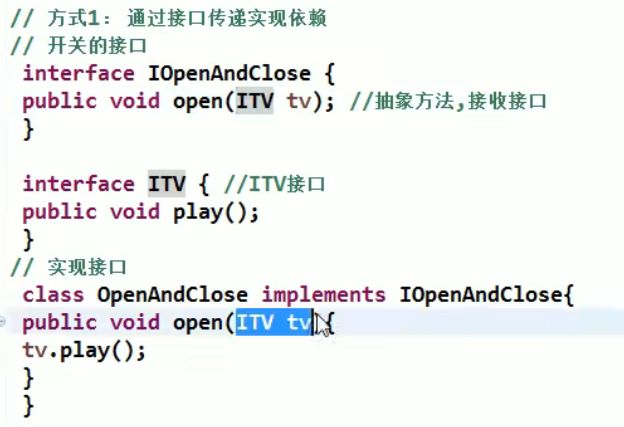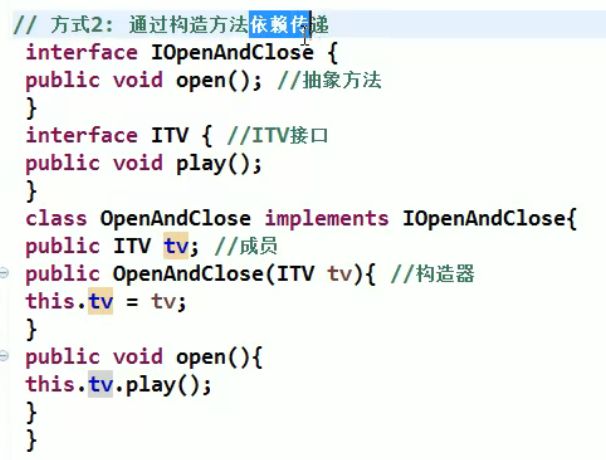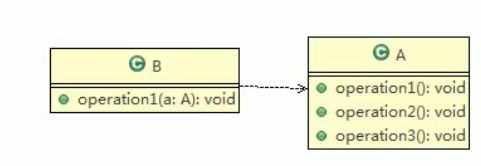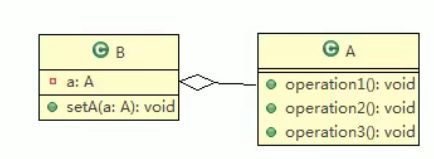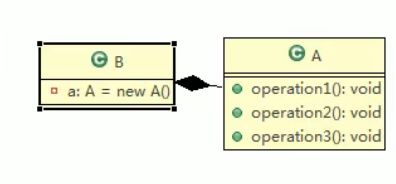设计模式——七大原则详解
目录
- 设计模式
- 单一职责原则
-
- 应用实例
- 注意事项和细节
- 接口隔离原则
-
- 应用实例
- 依赖倒转(倒置)原则
-
- 基本介绍
- 实例代码
- 依赖关系传递的三种方式
- 注意事项和细节
- 里氏替换原则
-
- 基本介绍
- 实例代码
- 开闭原则
-
- 基本介绍
- 实例代码
- 迪米特法则
-
- 基本介绍
- 实例代码
- 注意事项和细节
- 合成复用原则
-
- 基本介绍
- 设计原则的核心思想
设计模式
设计模式原则:其实就是程序员在编程时,应当遵守的原则,也是各种设计模式的基础(设计模式为什么这么设计的依据)
编写软件的过程中,程序员面临着来自 耦合性 内聚性以及可维护性,可扩展性,重用性 灵活性,等多方面的挑战 设计模式是为了让软件具有更好的
- 代码重用性(相同功能的代码,不用多次编写)
- 可读性(编程规范性,便于其他程序员阅读和理解)
- 可扩展性(需要增加新的功能时,非常的方便)
- 可靠性(新增功能后,对原来的功能没有影响)
- 使程序呈现 高内聚 低耦合的特性
单一职责原则
对类来说,即一个类应该值负责一项职责,如类A负责两个不同的职责:职责1,职责2,当职责1需求变更而改变A时,可能造成职责2执行错误,所以需要将类A的粒度分解为A1 A2
应用实例
以交通工具为例
未遵循单一职责原则
package 单一职责原则;
/**
* 创建一个交通工具类测试
*
* @author Han
* @data 2023/10/18
* @apiNode
*/
public class VehicleTest {
public static void main(String[] args) {
Vehicle vehicle = new Vehicle();
vehicle.run("摩托车");
vehicle.run("三轮车");
// 运行结果 "飞机在地上运行……" 违反常理
// 违反单一职责原则
vehicle.run("飞机");
}
}
// 交通工具类
class Vehicle{
public void run(String vehicle) {
System.out.println(vehicle+"在地上运行……");
}
}
遵循单一职责原则(这里对类发生了较大的修改,继续优化)
package 单一职责原则;
/**
* 创建一个交通工具类测试2
* 将每个类型的交通工具职责分离
* @author Han
* @data 2023/10/18
* @apiNode
*/
public class VehicleTest2 {
public static void main(String[] args) {
// 陆地类型的交通工具
RoadVehicle roadvehicle = new RoadVehicle();
roadvehicle.run("摩托车");
roadvehicle.run("三轮车");
// 天空类型的交通工具
AirVehicle airvehicle = new AirVehicle();
airvehicle.run("飞机");
}
}
// 交通工具类(公路)
class RoadVehicle{
public void run(String vehicle) {
System.out.println(vehicle+"在地上运行……");
}
}
// 交通工具类(天上)
class AirVehicle{
public void run(String vehicle) {
System.out.println(vehicle+"在地上运行……");
}
}
第三种优化方式
/**
* 创建一个交通工具类测试
*
* @author Han
* @data 2023/10/18
* @apiNode
*/
public class VehicleTest3 {
public static void main(String[] args) {
Vehicle3 vehicle = new Vehicle3();
vehicle.runRode("三轮车");
vehicle.runAir("飞机");
}
}
// 交通工具类
// 这种修改方法没有对原来的类做较大的修改,知识增加方法
// 这里虽然没有在类上遵循单一职责原则,但是在方法上,仍然是遵守单一职责原则的
class Vehicle3{
public void runRode(String vehicle) {
System.out.println(vehicle+"在地上运行……");
}
public void runAir(String vehicle) {
System.out.println(vehicle+"在天上运行……");
}
}
注意事项和细节
- 降低类的复杂度,一个类只负责一项职责
- 提高类的可读性
- 降低变更的风险
- 通常情况下,我们应当遵守单依职责原则,只有逻辑足够简单,才可以咋代码级违反单一职责原则,只有类中方法数量足够少,可以在方法级别上保持单一职责原则
接口隔离原则
客户端不应该依赖他不需要依赖的接口,即一个类对另一个类的依赖应该建立在最小的接口上
应用实例
- 类A通过接口interface1依赖B ,类C通过接口interface1依赖D,如果接口interface1对于A和C类来说不是最小接口,那么类B和类D必须去实现他们不需要的方法
这种依赖关系的代码为:
package 接口隔离原则;
/**
* @author Han
* @data 2023/10/19
* @apiNode
*/
public interface TestCode {
public static void main(String[] args) {
// A通过接口依赖B 但只用到了1 2 3 方法
A a = new A();
B b = new B();
a.useMethod1(b);
a.useMethod2(b);
a.useMethod3(b);
// C通过接口依赖D 但只用到了1 4 5 方法
C c = new C();
D d = new D();
c.useMethod1(d);
c.useMethod2(d);
c.useMethod3(d);
}
}
interface Interface1 {
void method1();
void method2();
void method3();
void method4();
void method5();
}
// A通过接口依赖B 但只用到了1 2 3 方法
// 而实现的4 5 方法就白写了
class B implements Interface1 {
@Override
public void method1() {
System.out.println("B类实现了method1");
}
@Override
public void method2() {
System.out.println("B类实现了method2");
}
@Override
public void method3() {
System.out.println("B类实现了method3");
}
@Override
public void method4() {
System.out.println("B类实现了method4");
}
@Override
public void method5() {
System.out.println("B类实现了method5");
}
}
// C通过接口依赖D 但只用到了1 4 5 方法
// 2 3 方法就白写了
class D implements Interface1 {
@Override
public void method1() {
System.out.println("D类实现了method1");
}
@Override
public void method2() {
System.out.println("D类实现了method2");
}
@Override
public void method3() {
System.out.println("D类实现了method3");
}
@Override
public void method4() {
System.out.println("D类实现了method4");
}
@Override
public void method5() {
System.out.println("D类实现了method5");
}
}
// A类通过接口使用B类
// 使用时,因为B实现了接口,可以根据多态性质传入B类对象,即可使用B类中实现的方法
class A {
public void useMethod1(Interface1 interface1) {
interface1.method1();
}
public void useMethod2(Interface1 interface1) {
interface1.method2();
}
public void useMethod3(Interface1 interface1) {
interface1.method3();
}
public void useMethod4(Interface1 interface1) {
interface1.method4();
}
public void useMethod5(Interface1 interface1) {
interface1.method5();
}
}
// C类通过接口使用D类
// 使用时,因为D实现了接口,可以根据多态性质传入D类对象,即可使用D类中实现的方法
class C {
public void useMethod1(Interface1 interface1) {
interface1.method1();
}
public void useMethod2(Interface1 interface1) {
interface1.method2();
}
public void useMethod3(Interface1 interface1) {
interface1.method3();
}
public void useMethod4(Interface1 interface1) {
interface1.method4();
}
public void useMethod5(Interface1 interface1) {
interface1.method5();
}
}
这种方式会导致B类和C类都会有从不会使用的方法存在,没有遵循接口隔离原则
优化
- 将接口interface1拆分为独立的几个接口,类A和类C分别与他们需要的接口简历依赖关系。也就是采用接口隔离原则
- 接口interface1中出现的方法根据实际情况去拆分为3个接口
遵循接口隔离原则
package 接口隔离原则;
/**
* @author Han
* @data 2023/10/19
* @apiNode
*/
public interface TestCode2 {
public static void main(String[] args) {
// A通过接口依赖B 但只用到了1 2 3 方法
A a = new A();
B b = new B();
a.useMethod1(b);
a.useMethod2(b);
a.useMethod3(b);
// C通过接口依赖D 但只用到了1 4 5 方法
C c = new C();
D d = new D();
c.useMethod1(d);
c.useMethod4(d);
c.useMethod5(d);
}
}
// 拆解接口
// 一个类依赖1 2 3 方法,一个类依赖1 4 5 方法
/**
* 1接口定义 1 方法
* 2接口定义 2 3 方法
* 3接口定义4 5 方法
*/
interface Interface2 {
void method1();
}
interface Interface3 {
void method2();
void method3();
}
interface Interface4 {
void method4();
void method5();
}
// A通过接口依赖B 但只用到了1 2 3 方法
// 就去实现2 3 接口
class B2 implements Interface2, Interface3 {
@Override
public void method1() {
System.out.println("B类实现了method1");
}
@Override
public void method2() {
System.out.println("B类实现了method2");
}
@Override
public void method3() {
System.out.println("B类实现了method3");
}
}
// C通过接口依赖D 但只用到了1 4 5 方法
// 就去实现2 4 接口
class D2 implements Interface2, Interface4 {
@Override
public void method1() {
System.out.println("D类实现了method1");
}
@Override
public void method4() {
System.out.println("D类实现了method4");
}
@Override
public void method5() {
System.out.println("D类实现了method5");
}
}
// A类通过接口使用B类
// 使用时,因为B实现了接口,可以根据多态性质传入B类对象,即可使用B类中实现的方法
// 实现1 2 3 方法
class A2 {
public void useMethod1(Interface2 interface1) {
interface1.method1();
}
public void useMethod2(Interface3 interface1) {
interface1.method2();
}
public void useMethod3(Interface3 interface1) {
interface1.method3();
}
}
// C类通过接口使用D类
// 使用时,因为D实现了接口,可以根据多态性质传入D类对象,即可使用D类中实现的方法
class C2 {
public void useMethod1(Interface2 interface2) {
interface2.method1();
}
public void useMethod4(Interface4 interface4) {
interface4.method4();
}
public void useMethod5(Interface4 interface4) {
interface4.method5();
}
}
依赖倒转(倒置)原则
基本介绍
- 高层模块不应该依赖底层模块,二者都应该依赖其抽象
- 抽象不应该依赖细节,细节应该依赖抽象
- 依赖倒转(倒置)的中心思想是面向接口编程
- 依赖倒转原则是基于这样的设计理念:相对于细节的多变性,抽象的东西要稳定的多,以抽象为基础搭建的框架比以细节为基础的架构要稳定的多,在Java中,抽象指的是接口和抽象类,细节就是具体的实现类
- 使用接口或抽象类的目的是制定好规范,而不涉及任何具体的操作,把展现的细节的任务交给他们的实现类去完成
实例代码
package 依赖倒转原则;
/**
* 依赖倒转原则 理解代码
* 传统方式
*
* @author Han
* @data 2023/10/20
* @apiNode
*/
// 定义一个接口 规范方法
interface IReceiver {
String getInfo();
}
/**
* 这样做的问题在哪里呢?
* 如果用户Person要的是微信消息,或者qq消息呢 不要email
* 还需在Person增加响应的方法
*/
public class testCode2 {
public static void main(String[] args) {
Person2 person = new Person2();
person.reverse(new Email1());
person.reverse(new QQ());
}
}
// 实现类实现接口中的方法
class Email1 implements IReceiver {
@Override
public String getInfo() {
return "电子邮件发送的信息";
}
}
class QQ implements IReceiver {
@Override
public String getInfo() {
return "QQ邮件发送的信息";
}
}
// 在调用类中传入接口的“对象”
// 运行时会因为多态而运行对应实现类的方法
// 这样Person只需要在类中实现一个方法
class Person2 {
// 可以传入实现了Ireserve接口的实现类对象
public void reverse(IReceiver rieserve) {
System.out.println(rieserve.getInfo());
}
}
优化后
package 依赖倒转原则;
/**
* 依赖倒转原则 理解代码
* 传统方式
*
* @author Han
* @data 2023/10/20
* @apiNode
*/
// 定义一个接口 规范方法
interface IReceiver {
String getInfo();
}
/**
* 这样做的问题在哪里呢?
* 如果用户Person要的是微信消息,或者qq消息呢 不要email
* 还需在Person增加响应的方法
*/
public class testCode2 {
public static void main(String[] args) {
Person2 person = new Person2();
person.reverse(new Email1());
person.reverse(new QQ());
}
}
// 实现类实现接口中的方法
class Email1 implements IReceiver {
@Override
public String getInfo() {
return "电子邮件发送的信息";
}
}
class QQ implements IReceiver {
@Override
public String getInfo() {
return "QQ邮件发送的信息";
}
}
// 在调用类中传入接口的“对象”
// 运行时会因为多态而运行对应实现类的方法
// 这样Person只需要在类中实现一个方法
class Person2 {
// 可以传入实现了Ireserve接口的实现类对象
public void reverse(IReceiver rieserve) {
System.out.println(rieserve.getInfo());
}
}
依赖关系传递的三种方式
接口传递
构造方法传递
setter传递
注意事项和细节
- 底层模块尽量都要有抽象类和接口,或者两者都有,程序稳定性更好
- 变量的声明类型尽量是抽象类或接口,这样我们的变量引用和实际对象之间,就存在一个缓冲层,利于程序扩展和优化
- 继承时遵循里式替换原则
里氏替换原则
基本介绍
- 如果对每个类型为T1的对象o1,都有类型为T2的对象o2,使得以T1定义的所有程序p在所有的对象o1都代换为o2时,程序p的行为没有发生变化,那么类型T2是类型T1的子类型,换句话说,所有引用基类的地方必须能透明地使用其子类的对象
- 在使用继承时,遵循里式替换原则,在子类中尽量不要重写父类的方法
- 里式替换原则告诉我们,继承实际上让两个类耦合性增强了,在适当的情况下,可以通过聚合,组合,依赖 来解决问题
实例代码
为遵循里式替 换原则
package 里氏替换原则;
/**
* 案例,因为错误的重写父类方法导致程序出现错误
*
* @author Han
* @data 2023/10/20
* @apiNode
*/
public class testCode1 {
public static void main(String[] args) {
A a = new A();
System.out.println("3 - 2 = " + a.func1(3, 2));
// 下面出现错误,因为子类不小心错误的重写了父类的方法
A b = new B();
System.out.println("3 - 2 = " + b.func1(3, 2));
B b1 = new B();
System.out.println("3 - 2 = " + b1.func2(3, 2));
}
}
class A {
// 返回两个数的差
public double func1(int i, int j) {
return i - j;
}
}
class B extends A {
// 重写错误
@Override
public double func1(int i, int j) {
return i + j;
}
public double func2(int a, int b) {
return func1(a, b) + 9;
}
}
优化后
避免重写父类方法,采用组合的方式优化
package 里氏替换原则;
/**
* 案例,因为错误的重写父类方法导致程序出现错误
*
* @author Han
* @data 2023/10/20
* @apiNode
*/
public class testCode2 {
public static void main(String[] args) {
A2 a = new A2();
System.out.println("3 - 2 = " + a.func1(3, 2));
B2 b1 = new B2();
System.out.println("3 + 2 + 9 = " + b1.func2(3, 2));
System.out.println("3 - 2 = " + b1.func3(3, 2));
}
}
class Base {
// 这里放更基础的方法
}
class A2 extends Base {
// 返回两个数的差
public double func1(int i, int j) {
return i - j;
}
}
class B2 extends Base {
// 组合A2
A2 a2 = new A2();
public double func3(int i, int j) {
return i - j;
}
// 没有重写父类的方法,与A类也没有耦合
public double func2(int a, int b) {
// 采用组合的方式替换
return this.a2.func1(a, b) + 9;
}
}
开闭原则
基本介绍
- 开闭原则是编程中最基础,最重要的设计原则
- 一个软件实体如类,模块和函数应该对扩展开放(对提供方),对修改关闭(对使用方)。用抽象构建框架,用实现扩展细节
- 当软件需要变化时,尽量通过扩展软件实体的行为来实现变化,而不是通过修改已有的代码来实现变化
- 编程中遵循其他原则,以及使用设计模式的目的就是遵循开闭原则
实例代码
现在有一个绘画功能的程序,只能绘画圆形
package 开闭原则;
/**
* @author Han
* @data 2023/10/21
* @apiNode
*/
public class testCode {
public static void main(String[] args) {
Hua hua = new Hua();
hua.hua(new Circle());
}
}
class Shape {
int m_type;
}
// 使用方
class Hua {
public void hua(Shape shape) {
if (shape.m_type == 1) {
System.out.println("圆形");
}
}
}
// 提供方
class Circle extends Shape {
public Circle() {
super.m_type = 1;
}
}
我要给这个类增加一个绘画三角形的方法
- 方式一
package 开闭原则;
/**
* @author Han
* @data 2023/10/21
* @apiNode
*/
public class testCode {
public static void main(String[] args) {
Hua hua = new Hua();
hua.hua(new Circle());
hua.hua(new Triangle());
}
}
class Shape {
int m_type;
}
// 使用方
class Hua {
public void hua(Shape shape) {
if (shape.m_type == 1) {
System.out.println("圆形");
}else if (shape.m_type == 2) {
System.out.println("三角形");
}
}
}
// 提供方
class Circle extends Shape {
public Circle() {
super.m_type = 1;
}
}
class Triangle extends Shape {
public Triangle() {
super.m_type = 2;
}
}
方式1的优缺点:
- 优点是比较好理解,简单易操作。
- 缺点是违反了设计模式的 ocp(开闭原则),即对扩展开方(提供方),对修改(使用方)关闭,即当我们给类增加新功能的时候,尽量不修改代码,或者尽可能的少修改代码,但是这里对使用方作了修改,违反开闭原则
- 比如我们要新增三角形,我们需要做刚才的修改,修改的地方较多
改进方式1
- 方式二
在抽象父类shape中创建一个 draw方法 ,让子类去实现即可,这样我们有新的图形种类时,只需要让新的图形类去继承这个Shape抽象类,并实现draw方法即可,使用方的代码就不需要修改
package 开闭原则;
/**
* @author Han
* @data 2023/10/21
* @apiNode
*/
public class testCode2 {
public static void main(String[] args) {
Hua2 hua2 = new Hua2();
hua2.hua(new Circle2());
hua2.hua(new Triangle2());
}
}
abstract class Shape2 {
public abstract void hua();
}
// 使用方
class Hua2 {
// 再增加图形时,只需要让图形对应的类继承shape2这个抽象类就好了
public void hua(Shape2 shape2) {
shape2.hua();
}
}
// 提供方
// 继承了抽象类
class Circle2 extends Shape2 {
@Override
public void hua() {
System.out.println("圆形");
}
}
class Triangle2 extends Shape2 {
@Override
public void hua() {
System.out.println("三角形");
}
}
迪米特法则
基本介绍
- 一个类应该对其他对象保持最少的了解
- 类与类关系越密切,耦合度越大
- 迪米特法则又叫最少知道法则,即一个类对自己依赖的类知道的越少越好,也就是说,对于被依赖的类不管多么复杂,都尽量将逻辑封装在类的内部。对外除了提供public方法,不对外泄露任何信息
- 迪米特法则还有个更简单的定义:只与直接的朋友通信
- **直接的朋友:**每个对象都会与其他对象有耦合关系,只要两个对象之间有耦合关系,我们就说这两个对象之间是朋友关系,耦合的方式很多,依赖,关联,组合,聚合等, 其中,我们称出现在成员变量,方法参数,方法返回值中的类为直接的朋友,而出现在局部变
量中得类不是直接的朋友,也就是说,陌生的类最好不要以局部变量的形式出现 在类的内部
实例代码
这种方式违反了迪米特法则,在几局部变量中出现了陌生类
package 迪米特法则;
import java.util.ArrayList;
import java.util.List;
public class Demeter1 {
public static void main(String[] args) {
// TODO Auto-generated method stub
SchoolManager schoolManager = new SchoolManager();
schoolManager.printAllEmployee(new CollegeManager());
}
}
class CollegeManager {
public List<CollegeEmployee> getAllEmployee() {
List<CollegeEmployee> list = new ArrayList<CollegeEmployee>();
for (int i = 0; i < 10; i++) {
CollegeEmployee emp = new CollegeEmployee();
emp.setId("学院员工id= " + i);
list.add(emp);
}
return list;
}
}
// 学校管理类
class SchoolManager {
// Employee是类的直接朋友
public List<Employee> getAllEmployee() {
List<Employee> list = new ArrayList<>();
for (int i = 0; i < 5; i++) {
Employee emp = new Employee();
emp.setId("学校总部员工id= " + i);
list.add(emp);
}
return list;
}
// CollegeManager是类的直接朋友
void printAllEmployee(CollegeManager sub) {
// CollegeEmployee不是类的直接朋友,是一个陌生类
// 这里违反了迪米特法则,陌生类最好不要以局部变量的方式出现在类的内部
List<CollegeEmployee> list1 = sub.getAllEmployee();
System.out.println("------------分公司员工------------");
for (CollegeEmployee e : list1) {
System.out.println(e.getId());
}
List<Employee> list2 = this.getAllEmployee();
System.out.println("------------学校总部员工------------");
for (Employee e : list2) {
System.out.println(e.getId());
}
}
}
class Employee {
private String id;
public String getId() {
return id;
}
public void setId(String id) {
this.id = id;
}
}
class CollegeEmployee {
private String id;
public String getId() {
return id;
}
public void setId(String id) {
this.id = id;
}
}
改进,遵循迪米特法则
package 迪米特法则;
import java.util.ArrayList;
import java.util.List;
public class Demeter2 {
public static void main(String[] args) {
// TODO Auto-generated method stub
SchoolManager2 schoolManager = new SchoolManager2();
schoolManager.printAllEmployee(new CollegeManager2());
}
}
class CollegeManager2 {
// 封装学院员工信息
public List<CollegeEmployee> getAllEmployee() {
List<CollegeEmployee> list = new ArrayList<>();
for (int i = 0; i < 10; i++) {
CollegeEmployee emp = new CollegeEmployee();
emp.setId("学院员工id= " + i);
list.add(emp);
}
return list;
}
// 输出学院员工信息
public void printCollegeInfo() {
List<CollegeEmployee> list1 = this.getAllEmployee();
for (CollegeEmployee e : list1) {
System.out.println(e.getId());
}
}
}
// 学校管理类
class SchoolManager2 {
// Employee是类的直接朋友
public List<Employee> getAllEmployee() {
List<Employee> list = new ArrayList<>();
for (int i = 0; i < 5; i++) {
Employee emp = new Employee();
emp.setId("学校总部员工id= " + i);
list.add(emp);
}
return list;
}
// CollegeManager是类的直接朋友
void printAllEmployee(CollegeManager2 sub2) {
// 你是怎么输出的不要告诉我,我只要结果(遵循迪米特法则)
System.out.println("------------分学院员工------------");
sub2.printCollegeInfo();
List<Employee> list2 = this.getAllEmployee();
System.out.println("------------学校总部员工------------");
for (Employee e : list2) {
System.out.println(e.getId());
}
}
}
// bean类
class Employee2 {
private String id;
public String getId() {
return id;
}
public void setId(String id) {
this.id = id;
}
}
class CollegeEmployee2 {
private String id;
public String getId() {
return id;
}
public void setId(String id) {
this.id = id;
}
}
注意事项和细节
- 迪米特法则的核心是降低类之间的耦合
- **但是注意:**由于每个类都减少了不必要的依赖,因此迪米特法则只是要求降低类间(对象间)的耦合关系,并不是要求完全没有依赖关系
合成复用原则
基本介绍
原则是尽量使用合成,聚合的方式,而不是使用继承
- 继承方式,依赖性太强
使用方式优化依赖关系
- 将A对象当做方法参数 依赖
- 在B中引入A类型变量,聚合
- 在B中创建A的对象,组合
设计原则的核心思想
- 找出应用中可能需要变化之处,把他们独立出来,不要和那些不需要变化的代码混在一起
- 针对接口编程,而不是针对实现编程。
- 为了交互对象之间的松耦合设计而努力


